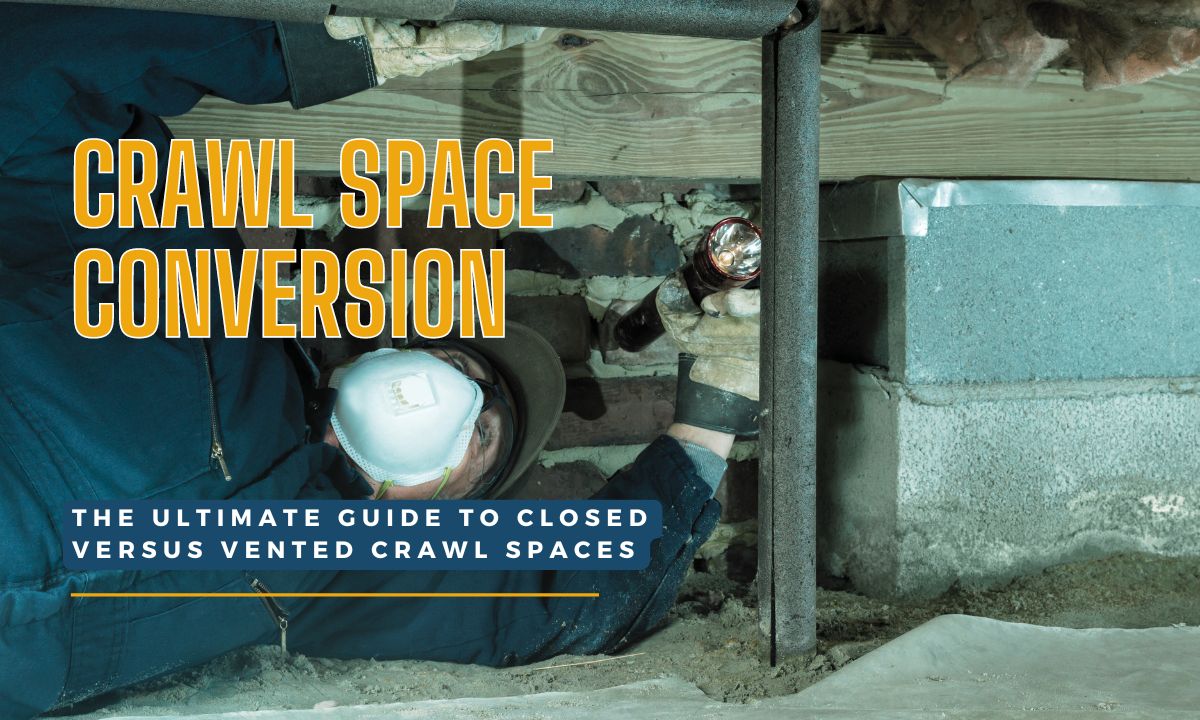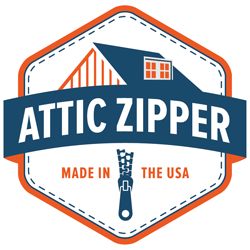
10 Apr Crawl Space Conversion: The Ultimate Guide to Closed Versus Vented Crawl Spaces
Converting your crawl space can have a profound impact on your home’s health, energy efficiency, and air quality. The debate between vented versus closed crawl spaces has been ongoing, but with modern HVAC systems and increased focus on energy efficiency, the solution is becoming clear. This article will guide you through the differences, the benefits of closing your crawl space, and how to take the next steps toward making this important home improvement.
Table of contents
Closed Versus Vented Crawl Spaces: What’s the Difference?
Vented Crawl Spaces: Outdated and Problematic
Vented crawl spaces were once the standard. The idea was to allow airflow under the home to prevent moisture buildup. In theory, this worked when air conditioning systems weren’t widespread. However, the introduction of air conditioning systems into homes brought new problems.
In a vented crawl space, outside air flows freely through vents, but when you cool your home to a comfortable 72°F while the outdoor temperature sits at 85°F with 80% humidity, the cool air inside collides with the warm, moist air outside. This leads to condensation forming on your floor joists, insulation, and ducts—an ideal breeding ground for mold, wood rot, and termites. This excess moisture can also result in costly structural damage, pest infestations, and poor air quality throughout the home.
Closed Crawl Spaces: A Modern Solution
A closed crawl space, on the other hand, is a sealed environment that eliminates outside airflow, controls moisture levels, and improves energy efficiency. The process of closing a crawl space involves:
- Sealing all vents
- Installing a vapor barrier to cover the ground and walls
- Insulating the crawl space, where necessary
- Conditioning the air inside the crawl space to maintain a consistent, dry environment
This method has become the standard for energy-efficient homes like LEED and NAHB Green Certified homes and is quickly becoming a recommended practice in building codes. By sealing off your crawl space, you protect your home from moisture-related issues while significantly improving its energy efficiency.
Why You Should Close Your Crawl Space
Research conducted by Advanced Energy, funded by the U.S. Department of Energy, found that closed crawl spaces outperform vented ones across the board. This study highlighted several common symptoms of vented crawl space moisture problems, such as:
- Mold or moisture damage
- Musty odors in the home
- Condensation on ductwork, pipes, or insulation
- Buckled hardwood floors
- High indoor humidity levels
- Pest infestations (including termites)
The Benefits of a Closed Crawl Space
By converting to a closed crawl space, you can experience numerous benefits that go beyond just moisture control:
1. Improved Air Quality
A sealed crawl space prevents mold growth, reduces allergens, and eliminates musty odors, improving the air quality inside your home.
2. Increased Energy Efficiency
Closed crawl spaces act as an energy reservoir, helping to maintain consistent indoor temperatures and reducing heating and cooling costs by up to 18%—especially in warm, humid climates.
3. Reduced Wood Decay and Structural Damage
Sealing off moisture prevents wood rot and decay in your floor joists, extending the life of your home’s structure and avoiding costly repairs.
4. Pest Prevention
By eliminating moisture, you create an environment that is inhospitable to pests, including termites and other insects.
5. More Comfortable Floors
During colder months, a closed crawl space helps to keep your floors warmer and more comfortable.
Crawl Space Conversion Process: How It Works
Converting a vented crawl space into a closed one involves a few critical steps. Here’s what the process typically looks like:
Step 1: Sealing the Vents
All vents that allow outside air to enter your crawl space are sealed off. This is the first step to controlling humidity and moisture.
Step 2: Installing a Vapor Barrier
A heavy-duty vapor barrier is laid across the floor and extended up the foundation walls. This barrier helps block moisture from the ground from entering the crawl space and affecting your home’s structure.
Step 3: Addressing Moisture Sources
Before fully encapsulating the space, it’s important to address any sources of standing water or leaks. In some cases, installing a drainage system or sump pump may be necessary to ensure the crawl space stays dry.
Step 4: Adding Insulation
Depending on your home’s specific conditions, insulation is added to the foundation walls or the underside of the floor above. This helps improve energy efficiency by regulating the temperature inside the crawl space.
Step 5: Conditioning the Air
Finally, air is conditioned inside the crawl space by using a dehumidifier or HVAC system to maintain low humidity levels. This ensures the space remains dry and healthy.
Why Attic Zipper is the Best Choice for Sealing Your Crawl Space
When closing your crawl space, one key component is sealing the entryway. Products like the Crawl Space Zipper from Attic Zipper provide a durable, easy-to-install solution for sealing the crawl space door. This zipper system creates an airtight seal that prevents air leakage and improves overall energy efficiency.
Unlike traditional crawl space doors that can warp, deteriorate, or allow moisture to enter, the Crawl Space Zipper is designed for long-term durability, ensuring that your crawl space remains sealed and protected for years to come.
For the best results, consider adding the Crawl Space Zipper to your crawl space conversion process. It’s a small investment that pays off in increased energy savings, improved air quality, and enhanced home protection.
Over 80 Million Homes Need Crawl Space Conversion
Did you know that over 80 million homes in the U.S. are built over crawl spaces? And approximately 18% of all new homes continue to be built on crawl spaces each year. By converting vented crawl spaces into closed systems, millions of homeowners can improve their indoor air quality, save on energy costs, and reduce the risk of structural damage from moisture.
This is why we’re committed to spreading awareness about crawl space conversion and helping families create healthier, more energy-efficient homes.
Take Action Today
Ready to convert your crawl space and enjoy a healthier, more efficient home? Visit Attic Zipper’s shop to explore our range of crawl space products, including the Crawl Space Zipper, or give us a call to learn more about how we can help you with your crawl space conversion. Our expert team is here to answer your questions and guide you through the process.
Conclusion
A crawl space conversion is more than just a home improvement project—it’s an investment in your family’s health, comfort, and long-term savings. By sealing off your crawl space, installing a vapor barrier, and conditioning the air, you can prevent moisture damage, reduce energy costs, and enjoy a cleaner, healthier living environment. With innovative products like the Crawl Space Zipper from Attic Zipper, sealing your crawl space entry has never been easier or more effective.
Don’t wait—take the first step toward a better home today.
FAQs
1. How long does it take to convert a crawl space?
A typical crawl space conversion can take anywhere from 2 to 5 days, depending on the size of the space and the extent of any existing moisture issues.
2. Do I need a professional to close my crawl space?
While some homeowners may choose to tackle parts of the project themselves, it’s recommended to hire a professional to ensure proper sealing, insulation, and moisture control.
3. How much does crawl space conversion cost?
Costs vary depending on the size of your crawl space and the materials used. On average, expect to pay between $5,000 and $15,000 for a full conversion.
4. What is the purpose of a vapor barrier?
A vapor barrier prevents moisture from the ground from entering your crawl space, which can lead to mold growth, wood rot, and poor air quality in your home.
5. Will a closed crawl space increase my home’s resale value?
Yes! A closed crawl space can improve your home’s energy efficiency and indoor air quality, which are attractive features to potential buyers.



